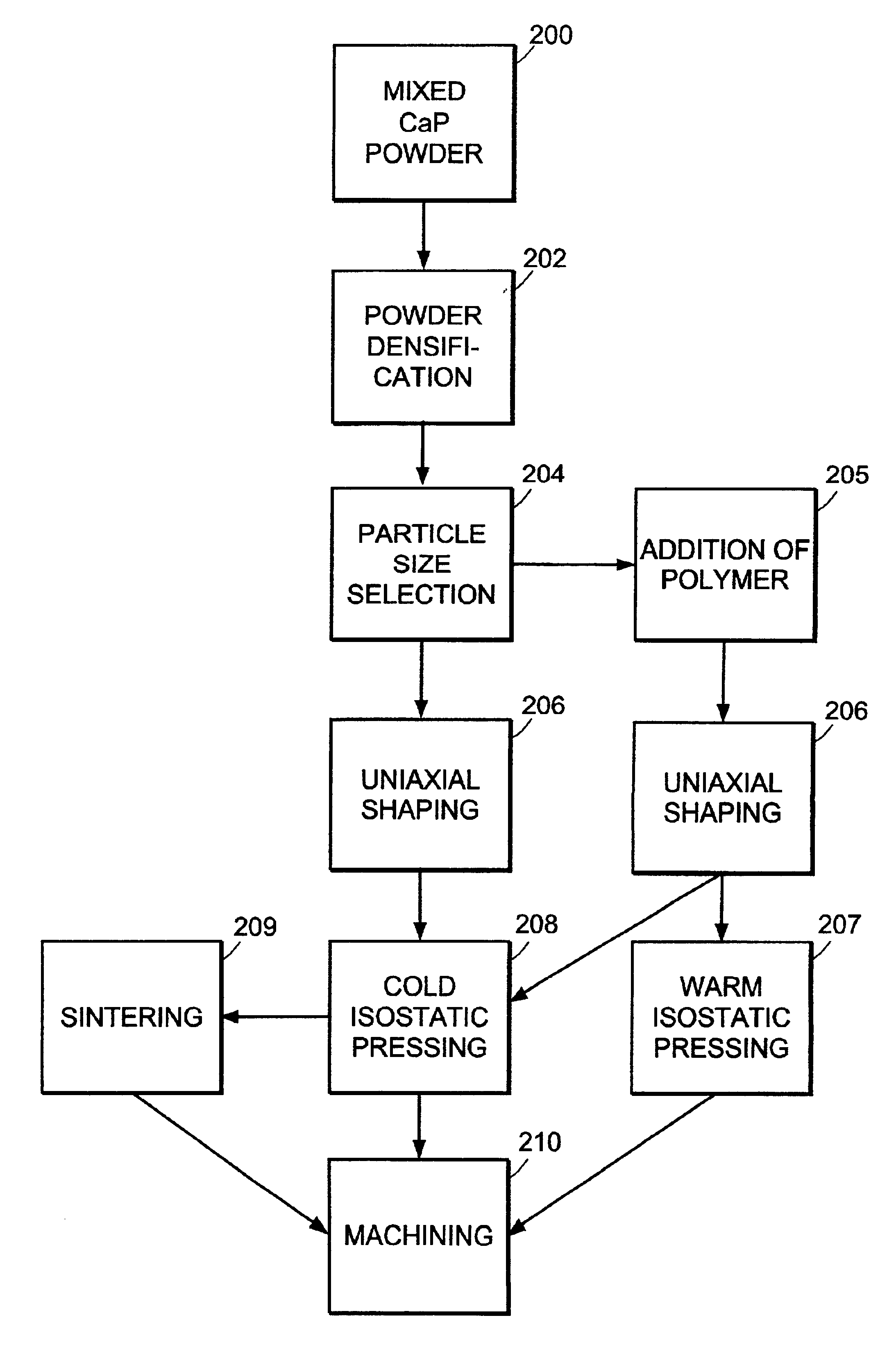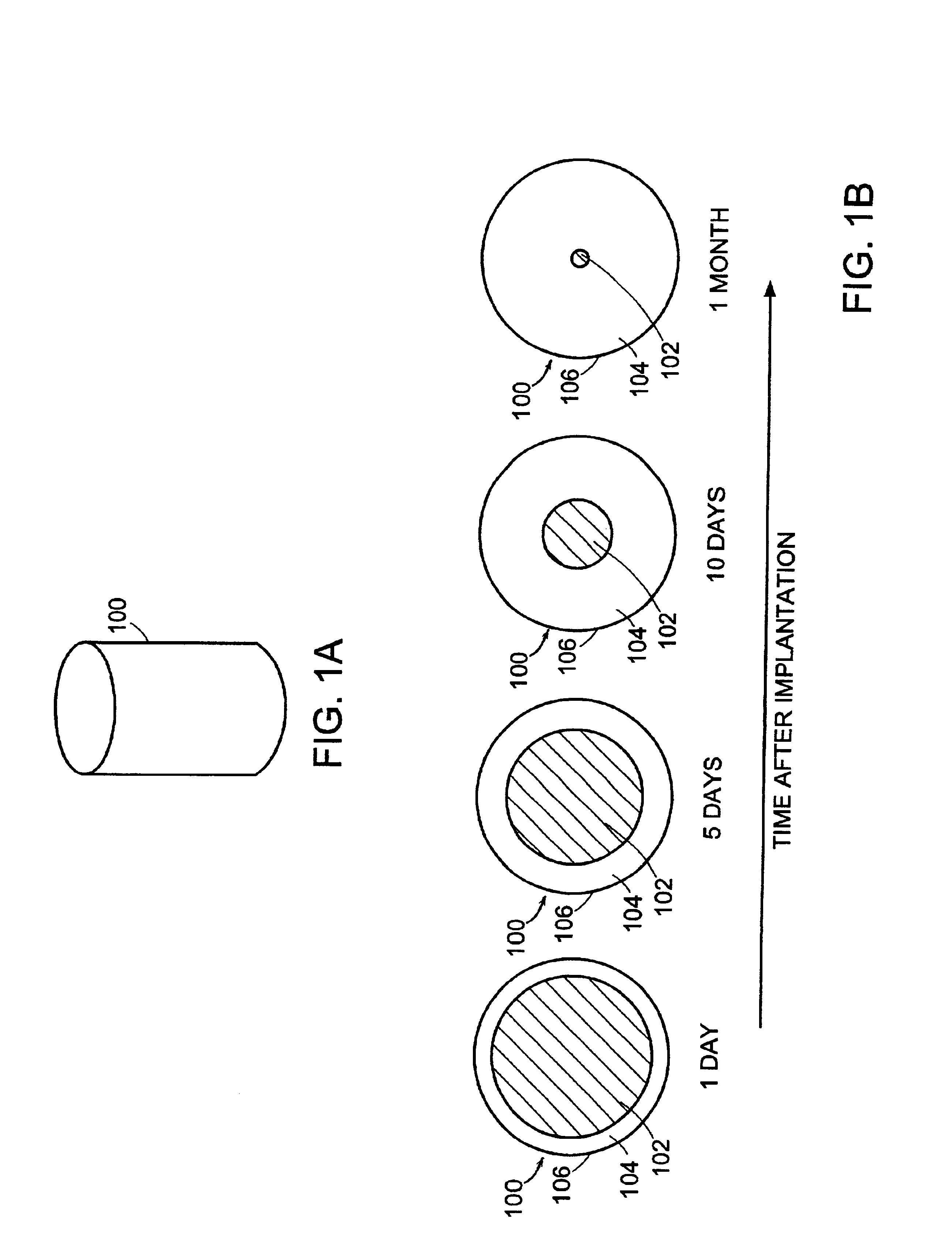Machinable preformed calcium phosphate bone substitute material implants
- Summary
- Abstract
- Description
- Claims
- Application Information
AI Technical Summary
Benefits of technology
Problems solved by technology
Method used
Image
Examples
example 1
Synthesis of Amorphous Calcium Phosphate
[0048]A solution of 150 g disodium hydrogen phosphate heptahydrate (Na2HPO4·7H2O) in 2167 mL distilled water was prepared and stirred. 83.3 g NaOH, 50 g NaHCO3, and 3.3 g sodium pyrophosphate decahydrate (Na4P2O7·10H2O) were added sequentially to the solution to form solution 1.
[0049]A solution of 31.2 g calcium nitrate tetrahydrate (Ca(NO3)2·4H2O) in 833 mL distilled water was prepared and stirred. 1.7 g magnesium chloride hexahydrate (MgCl2·6H2O) was added to the solution to form solution 2.
[0050]Solution 2 was poured quickly into solution 1 at room temperature and stirred for 1 minute. Precipitation was immediate and substantially complete. The pH of the suspension was 13±0.5, which was maintained to avoid conversion of the precipitate to an apatite or other more crystalline calcium phosphate. The precipitate was promptly separated from its mother solution by basket centrifugal filtration and washed with about 15 L distilled water. Completi...
example 2
Preparation of Dicalcium Phosphate Dihydrate
[0051]20 g diammonium hydrogen phosphate ((NH4)2·HPO4) was dissolved in 1 L distilled water to prepare solution 3 with a concentration of 0.300 mol / L. It was verified that the pH of solution 3 was between 7.0 and 9.0.
[0052]35.5 g calcium nitrate tetrahydrate (Ca(NO3)2·4H2O) was dissolved in 0.5 L distilled water to prepare solution 4 with a concentration of 0.300 mol / L. It was verified that the pH of solution 4 was between 5.0 and 8.0.
[0053]Solution 4 was poured into solution 3, followed by stirring for about 2 minutes. It was verified that the pH of the resulting suspension was between 5.2 and 6.2. The suspension was filtered by vacuum filtration to form a uniform cake. The cake was washed three times with 750 mL distilled water (2.25 L total). When washing was complete, the cake was separated from the filter paper and dried in a laminar flow hood for 24 hours. The dried powder was milled through a 120 μm nominal pore size screen.
example 3
Bone Substitute Material Dowels
[0054]100 g (˜250 mL) lots of a mixture of equal parts by weight amorphous calcium phosphate (ACP) and dicalcium phosphate dihydrate (DCPD) were ground into a homogeneous powder by ball milling in a 3440 mL alumina ceramic jar. Milling was performed using 750 mL of media (10 mm diameter balls of high purity zirconium oxide stabilized by Y2O3) at 100 rpm for 3 hours. The resultant powder was sieved to remove particles of size >125 μm. Solid cylindrical dowels 17 mm in diameter and 23 mm long were formed from the sieved powder using a uniaxial press. Uniaxial shaping was performed, creating a cylindrical shape by applying 0.25 tons of force to the powder in a die. Then isostatic pressing was performed between 30,000 psi and 44,000 psi, either cold (CIP) at room temperature, or warm (WIP) at about 66° C. Polymer powder or fiber, added after milling, was included in some dowels. Some dowels were sintered at 1100° C. in an argon atmosphere after isostatic p...
PUM
 Login to View More
Login to View More Abstract
Description
Claims
Application Information
 Login to View More
Login to View More - R&D
- Intellectual Property
- Life Sciences
- Materials
- Tech Scout
- Unparalleled Data Quality
- Higher Quality Content
- 60% Fewer Hallucinations
Browse by: Latest US Patents, China's latest patents, Technical Efficacy Thesaurus, Application Domain, Technology Topic, Popular Technical Reports.
© 2025 PatSnap. All rights reserved.Legal|Privacy policy|Modern Slavery Act Transparency Statement|Sitemap|About US| Contact US: help@patsnap.com



